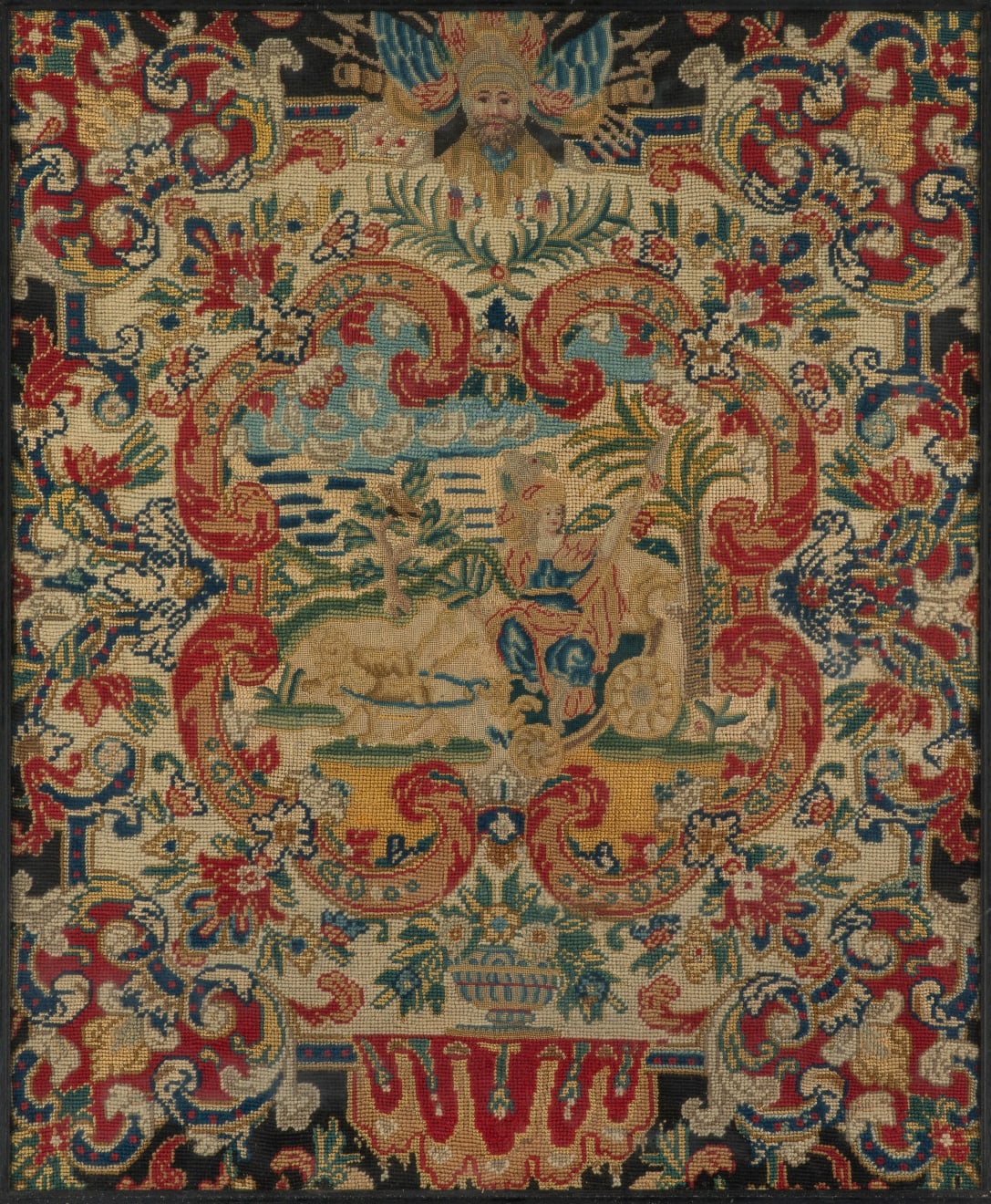Needlepoint Depicting The Goddess Cybele
FRANCE, LATE 17TH/EARLY 18TH CENTURY
77 x 62 cm
30 ¼ x 24 ½ in
30 ¼ x 24 ½ in
JL41
Provenance
Acquired from Mallet circa 1995?Private Collection, Switzerland
Depicting the Triumph of Cybele. The goddess on her chariot is executed in silk using petit point tent stitch. The same technique has been used for the finest and most...
Depicting the Triumph of Cybele. The goddess on her chariot is executed in silk using petit point tent stitch. The same technique has been used for the finest and most important elements of the design including the bearded figure above, the owl in the tree and the classical flower-filled vase below which stands on a table draped with a shaped cloth. The remainder of the design is executed in gros point with coloured wools and comprises the central C-scroll cartouche and floral and foliate designs. The needlework may have been designed for use to cover a chair back or as a pole screen.
Cybele is a goddess representing motherhood, said to be the mother of all gods, humans and animals. She appears in Greek and Roman literature from the 5th century BC and is closely identified with the Anatolian Great Mother Cybele whose cult was imported to Rome from Asia Minor on the advice of the Sybilline Books in 204BC. She is typically represented as a crowned and veiled figure on a chariot drawn by lions. She is often depicted surrounded by wild animals. In this case the needleworker has chosen to include an owl in the tree.
The figure of Cybele has appeared in many art forms since antiquity. For comparators for this design, see Cybele in her chariot drawn by two lions by the Master of the Die (Italian, active Rome, ca. 1530–60) After Baldassare Tommaso Peruzzi (Italian, Ancaiano 1481–1536 Rome), engraving c. 1530–60 Metropolitan Museum of Art, Object Number: 60.712.1 and The Triumph of Cybele by Pinturicchio (Italian, Perugia 1454–1513 Siena), c. 1509, fresco, transferred to canvas, Metropolitan Museum of Art, Object Number: 14.114.9.
Cybele's origins from Asia Minor and as an earth goddess account for similar compositions representing Earth or Asia. See the print 'Terra - La Terre' from the series 'The Four Elements' depicting the triumph of Cybele, 1721, etching and engraving by Charles Dupuis after Louis de Boullogne, British Museum no. X,7.10 and Allegory of Asia, from "The Four Continents" by Julius Goltzius (Netherlandish, died ca. 1595) engraving after Maerten de Vos (Netherlandish, Antwerp 1532–1603 Antwerp) c. 1560–90 Metropolitan Museum of Art, Object Number: 49.95.1523.
The style of this textile can be compared with the tapestry designs of Charles Le Brun (1619–1690), whose schemes for a series of eight embroidered tapestries made circa 1686-87 for Marshal François de Blanchefort de Créqui (1629–1687), include a personification of Earth. It comprises a centrally placed medallion in scrolling and profusely populated borders, in which there is a representation of Cybele wearing a mural crown and holding a sceptre, with her attributes - the lions. (Jagiellonian University Museum, Collegium Maius no. 842; 220/IV).
Cybele is a goddess representing motherhood, said to be the mother of all gods, humans and animals. She appears in Greek and Roman literature from the 5th century BC and is closely identified with the Anatolian Great Mother Cybele whose cult was imported to Rome from Asia Minor on the advice of the Sybilline Books in 204BC. She is typically represented as a crowned and veiled figure on a chariot drawn by lions. She is often depicted surrounded by wild animals. In this case the needleworker has chosen to include an owl in the tree.
The figure of Cybele has appeared in many art forms since antiquity. For comparators for this design, see Cybele in her chariot drawn by two lions by the Master of the Die (Italian, active Rome, ca. 1530–60) After Baldassare Tommaso Peruzzi (Italian, Ancaiano 1481–1536 Rome), engraving c. 1530–60 Metropolitan Museum of Art, Object Number: 60.712.1 and The Triumph of Cybele by Pinturicchio (Italian, Perugia 1454–1513 Siena), c. 1509, fresco, transferred to canvas, Metropolitan Museum of Art, Object Number: 14.114.9.
Cybele's origins from Asia Minor and as an earth goddess account for similar compositions representing Earth or Asia. See the print 'Terra - La Terre' from the series 'The Four Elements' depicting the triumph of Cybele, 1721, etching and engraving by Charles Dupuis after Louis de Boullogne, British Museum no. X,7.10 and Allegory of Asia, from "The Four Continents" by Julius Goltzius (Netherlandish, died ca. 1595) engraving after Maerten de Vos (Netherlandish, Antwerp 1532–1603 Antwerp) c. 1560–90 Metropolitan Museum of Art, Object Number: 49.95.1523.
The style of this textile can be compared with the tapestry designs of Charles Le Brun (1619–1690), whose schemes for a series of eight embroidered tapestries made circa 1686-87 for Marshal François de Blanchefort de Créqui (1629–1687), include a personification of Earth. It comprises a centrally placed medallion in scrolling and profusely populated borders, in which there is a representation of Cybele wearing a mural crown and holding a sceptre, with her attributes - the lions. (Jagiellonian University Museum, Collegium Maius no. 842; 220/IV).




